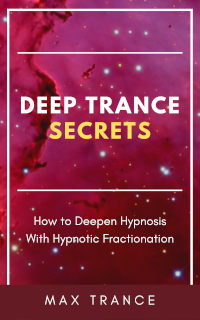Fractionation in hypnosis is a form of rote learning in which the subject progressively learns to go into hypnotic states. This is achieved by repeatedly guiding them into and out of specific hypnotic states. Each time they go into one of these states, they get better at it, and can go deeper more easily.
Over the years, I’ve had a lot of conversations with people about hypnotic fractionation. For some reason, many hypnotists seem to believe that it’s this mysterious thing that no-one knows how it works.
In reality, hypnotic fractionation is an extremely simple concept.
Here’s a truth: As human beings, the more we do something correctly, the better we get at it and the faster we tend to be able to do it the next time.
Where a lot of people get tripped up is in failing to realize that this applies not only to traditional skills like tying our shoelaces and doing math, but to everything we can learn.
Even the things we do unconsciously such as choosing which emotions to experience.
For most people, their emotional state is a result of the things that happen to them.
When we hypnotize people, we’re teaching them to override this default behavior and intentionally move from one state to another.
Fractionation is nothing more than repeated practice at correctly going in and out of hypnotic states. This is a learnable skill just like all the other ones we possess.
So how exactly do we fractionate hypnotic states in someone?
The simplest form of hypnotic fractionation
The simplest way to fractionate hypnosis subjects is to hypnotize them, bring them out of hypnosis, and then immediately hypnotize them again.
We can use any induction at all for this. The important thing is that the subject gets to practice moving from one state to another.
Because the important thing is that the subject gets to practice going in and out of trance, we can even change the induction with each cycle.
For example, if we’re starting out, we might use a progressive relaxation induction to hypnotize them, then bring them out again, check how they are doing, and immediately hypnotize them again with a guided imagery induction.
There are also some practical benefits in terms of the subject’s beliefs.
As a rule, hypnosis subjects have no idea what is supposed to happen. This means that if an induction appears to fail, and you bring them out then immediately hypnotize them with another induction, they will tend to think it is part of the process.
And it’s even better than that.
When hypnotic inductions fail, if you act like everything is going to plan and continue on into another induction, it will appear to be a part of the process to your subject.
With each induction, they will get closer to experiencing trance.
So long as you don’t stop, sooner or later they will go into hypnosis.
How to quickly deepen trance with fractionation
The easiest way to use fractionation to quickly deepen hypnosis is by setting up a hypnotic trigger to re-hypnotize the subject on subsequent cycles.
Setting up a hypnotic trigger is easy: Hypnotize and deepen your subject, then while they are in hypnosis say something like every time you hear me say the word SLEEP you will instantly return to a wonderful, blissful state of hypnosis, twice as deep as ever before, only when it’s safe and appropriate to do so.
Riff around the basic idea that the word SLEEP will return them to hypnosis a few times, then bring them back out and immediately test by saying the word SLEEP to them.
Once you’ve set up a trigger like this, it becomes very easy to quickly return subjects to hypnosis. In turn, this makes it easy to fractionate them.
Incidentally, you can use just about anything your subject can perceive as the trigger here. The word SLEEP tends to be used because it carries with it some unconscious biases. While undoubtedly beneficial, these biases are not required for the trigger to work.
Hypnotic triggers are one form of a hypnotic anchor. If you’d like to know more about anchors, you can find what I hope is a fluff-free guide to them in my book Artful Hypnotic Anchoring. I’ve designed the book to take people from not knowing what an anchor is to being able to set and use them quickly and easily.
Types of hypnotic fractionation
Fractionation can be used to increase someone’s experience of any state at all, not just hypnosis.
As a rule, anything we can do to cause someone to change states and then bring them back again will intensify the state.
For example, consider a comedy show. The creators of the show know that it’s not viable to have the entire audience laughing constantly for the duration of the show, so they break it up. There are parts designed to make us laugh, and other parts designed to do the opposite. Sometimes there are multiple transitions like this in the space of a single sentence.
When they do this, what tends to happen is that the overall positive state of the audience increases throughout the show.
It’s the same with every other form of entertainment we have.
The creators design their content to cycle us through a series of states.
Hypnosis is no different. And that means that we have a large range of things we can do to fractionate our subjects.
Attentional hypnotic fractionation
To fractionate someone’s focus and attention, alternate between talking about fine detail and the big picture.
One of the most common methods that skilled hypnotists use to fractionate our subjects is by simply moving their attention around.
Hypnosis relies significantly on our subjects being able to focus on just one idea for a time.
So when we move their attention from big picture to fine detail, we are helping them to practice building the skill of focusing. In turn, this leads them down the pathway into hypnosis.
There are lots of ways that this can be achieved.
If you’d like to see it in action, check out my articles on Guided Imagery Visualization Scripts. The scripts inside these articles were designed to constantly move the subject’s attention from looking at fine details like colors, textures, and so on, to the broader landscape, and back again.
And the best part? Unless your subject happens to be a hypnotist, it’s generally completely invisible to them.
Fractionate emotions
Beyond moving someone’s attention and focus around to induce trance, we can also fractionate their emotions.
When we do this, it teaches them how to move from one state to another.
In order to fractionate someone’s emotions, we need to learn how to guide people from emotion to emotion.
To change someone’s emotional state, first take on an emotion congruent with their current one. Then gradually change your own emotional state towards the one you’d like them to experience. They will typically follow along.
This takes a lot of practice to get right, but it is well worth the effort.
Once you can shape someone’s emotions, it becomes possible to fractionate them by moving them repeatedly into congruent emotions. For example, you might make them laugh by telling them a joke, letting them return to a neutral state, then telling them a heartwarming story.
As an aside, when starting out it tends to be best to always return to neutral. This allows you to have clean states.
The more someone moves from neutral to a specific emotional state, the easier it becomes for them to move that way.
Done properly, the state can become more intense with every cycle.
Eventually it becomes possible to fractionate people directly from more intense states like anger to uncontrollable laughter.
The issue is that this is more or less impossible for most people. Start out with small state changes to and from neutral, and allow them to grow with your skill.
Hypnotic fractionation of certainty
The easiest way to fractionate certainty is by using double, triple or quadruple negatives interspersed with statements that are totally clear.
When you do this, you get two huge benefits.
First, most people will consciously latch onto the clear statements and ignore the other ones. This increases their levels of certainty.
And second, the double, triple and quadruple negatives are brilliant places to insert embedded commands.
Even a double negative will overload most people. When you move up to triple and quadruple negatives, it becomes essentially impossible for anyone to track.
So the layered negatives will cause them to feel confusion and uncertainty, which in turn causes them to latch onto the clear statements even more strongly.
To use this, make a statement using a double negative, then follow up with a statement that is clear when you see the confusion on their face.
As with the rest of hypnosis, it takes practice to get this right, so start off small and work your way up.
Hypnotic fractionation of agreement
Fractionate agreement by occasionally having someone disagree with you, while mostly agreeing with them.
One of the most useful skills to have in life is the ability to build agreement with people.
A lot of people try to build agreement by simply getting others to agree with them a lot. Then they clumsily tack on something they hope their victim will also agree with.
While this can work, it’s also extremely easy for most people to spot. And once they spot it, they’re probably going to become annoyed and not agree with anything else you say.
Ever again.
Luckily there’s an easy way around this: Rather than having someone agree with everything, include things they won’t agree with as well.
There’s even a way to fake this. To fake disagreement, simply get them to say no rather than yes. This can be achieved by doing nothing more than stating something in the negative.
Here’s a simple example from the middle of an imagined hypnosis session:
Hypnotist: Wow! That looks like you’re having an amazing time there, aren’t you.
Subject: Yes.
Hypnotist: And you’ve been enjoying our little chat so far today?
Subject: Very much so.
Hypnotist: So I’m curious… you look like you’ve gone fairly deep already, and we’ve not even started yet! Does that sort of thing usually happen to you?
Subject: No, it doesn’t.
Hypnotist: That’s amazing! I can tell that you’re an exceptional subject and you’re going to have an awesome experience today. Are you okay with getting started right now?
Subject: Yes!
And so on. Variants of that conversation play out just about every time I hypnotize someone, and with good reason: When someone is given evidence that they’re an exceptional subject, they will tend to believe it. In turn, this leads to them having a better overall experience.
How to deepen trance with fractionation
To deepen trance with fractionation, simply keep on doing the fractionation after your subject is in hypnosis.
As you might imagine, there are lots and lots and lots of ways that this can be done.
I find that what tends to work best is to have a range of things available that I can use at any time. I like guided imagery visualizations quite a lot, so I tend to use multiple layers of these.
Guided imagery visualizations are brilliant because you can draw your subject’s attention to any details you might choose, giving you essentially infinite possibilities for hypnotic fractionation.
Deepen trance with a shamanic journey
One of the easiest visualizations to run is a shamanic journey. There are a range of these, and you can also make up your own.
To create a shamanic journey, describe a starting location in enough detail for it to begin to become real for your subject. I usually start with a field with a tree in it, but you can use anything you might choose.
Once your subject has a sense of the visualization, have them look around and find a pathway or tunnel.
Next, have them travel down the pathway, exploring the details as they go.
Finally, have them find a portal or doorway at some point along the tunnel and step through it into a hypnotic reality.
You can layer this as many times as you like to deepen trance and make it difficult for them to recall.
Once they’re inside the hypnotic reality, do whatever hypnosis you’ve agreed to.
To bring them out again, have them retrace their steps in reverse order, then have them orient themselves back into their body from the starting location.
Deepen trance with storytelling
Have you ever been so caught up in a novel, movie, or TV show that you lost track of everything else going on around you?
Of course you have!
Well constructed stories can be used to induce and deepen hypnosis.
This is a huge topic so I won’t go into it in detail here.
There is a basic structure that all stories have. If you feel so inclined, you can look up Joseph Campbell and learn all about the hero’s journey.
Or you can take the easy approach.
Start with the basic structure of a story: There’s a hero. They have a flaw that makes them relatable. They exist in some kind of everyday environment. Something disrupts the hero and they have to go on a quest to fix it. Some kind of problem arises during the quest. The hero overcomes their flaw (or perhaps uses it) to solve the problem.
Once you have the structure, think about what emotions you’d like your subject to experience as you tell them the story. Then shape the story to support those emotions, and allow yourself to experience them as you tell the story.
There’s a lot more to it, and as with all things, it’s important to start small and add things in as we gain skill.
Most of us are already good storytellers if we simply allow ourselves to get out of our own way.
So how do you use stories in the fractionation of your hypnosis subjects?
Good stories invoke emotional responses. So you can use storytelling as a framework to take your subject on an emotional journey.
At the same time, stories can impart morals and learnings, and layers of stories can be used to hide information from the subject’s conscious mind.
There’s a reason why stories are so effective: Our brains have evolved to process the ongoing stories of our lives, so stories are the native language that they speak.
When we put all of this together it’s possible to get profound hypnotic effects with what seems like just a few stories to your hypnosis subject.
Deepen trance with multi-dimensional hypnotic fractionation
So far we’ve covered some fairly time consuming ways to fractionate hypnotic states. So it makes sense to ask how quickly it’s possible to fractionate someone.
And the answer is 2 syllables.
Just 2 syllables are all you need to fractionate someone. And sometimes you can get away with just 1.
Or a pause.
Yep.
It’s literally possible to fractionate someone by not saying anything at all.
With multi-dimensional hypnotic fractionation, every word, every phrase, every concept, every tonality, every rate of speaking, and every pause has meaning.
To give a simple example, consider the word hypnosis.
When I pronounce hypnosis, it is often as hyp-nosis, with a tiny pause in the middle.
By itself the effect of this is tiny.
But when you stack up 100s of these constructs, the effects can become significant.
And with a little experience, it’s easy to place dozens of these within a single sentence.
The effects add up fast.
The easiest way to get started with multi-dimensional hypnotic fractionation is to start thinking about the implications of every word you use.
Think about the size of the underlying concept. What’s the difference between a pen and the pen?
Think about how that concept shifts and moves.
Think about the connotations of the words you’re using.
It takes time to do this.
It’s worth the effort though, because when you take the time to understand the nuances of words beyond just their simple meanings, and you use that in your hypnosis, suddenly everything you do becomes more hypnotic.
I go into this in my book, Deep Trance Secrets, which is all about how to guide people into deep trance using hypnotic fractionation. You can use it on other people, or on yourself. If that sounds interesting to you, go check it out!






